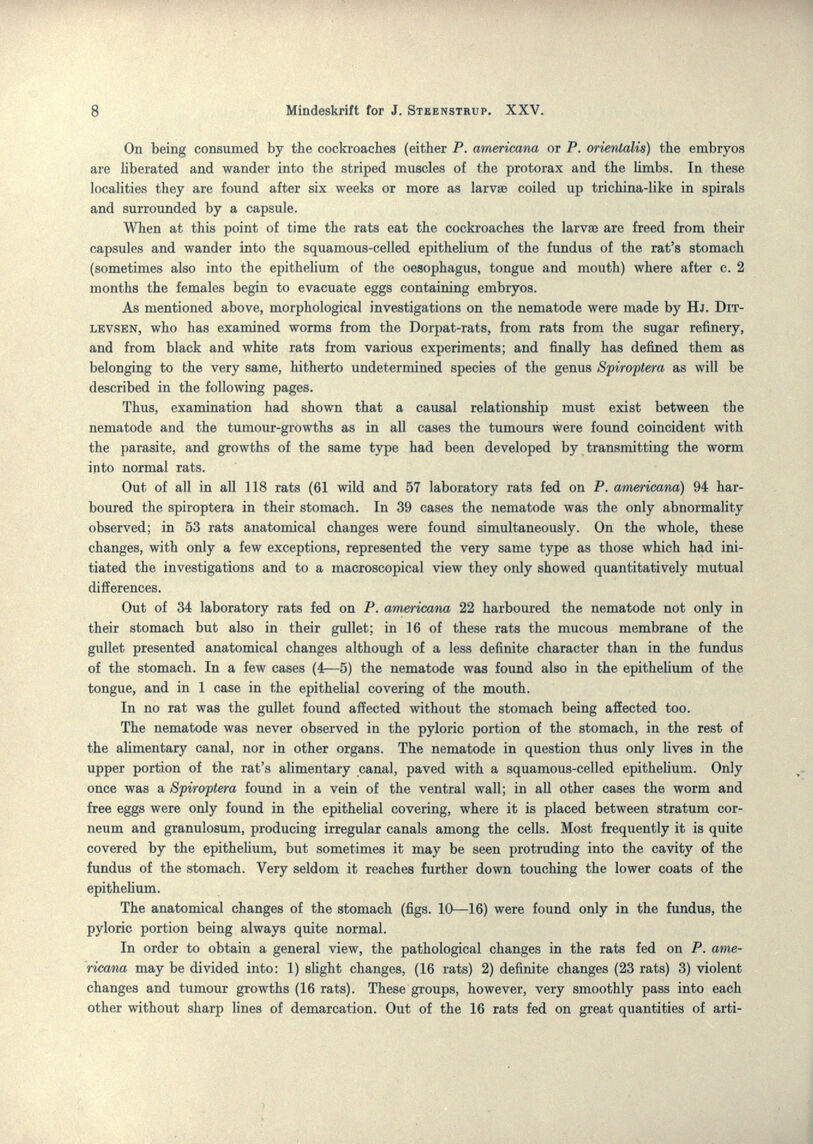
Full resolution (JPEG) - On this page / på denna sida - Contributions to the Biology and Morphology of Spiroptera (Gongylonema) Neoplastica n. sp.

<< prev. page << föreg. sida << >> nästa sida >> next page >>
Below is the raw OCR text
from the above scanned image.
Do you see an error? Proofread the page now!
Här nedan syns maskintolkade texten från faksimilbilden ovan.
Ser du något fel? Korrekturläs sidan nu!
This page has never been proofread. / Denna sida har aldrig korrekturlästs.
On being consumed by the cockroaches (either P. americana or P. orientalis) tbe embryos
are liberated and wander into the striped muscles of the protorax and the limbs. In these
localities they are found after six weeks or more as larvæ coiled up trichina-like in spirals
and surrounded by a capsule.
When at this point of time the rats eat tlie cockroaches the larvæ are freed from their
capsules and wander into the squamous-celled epithelium of the fundus of the rat’s stomach
(sometimes also into the epithehum of the oesophagus, tongue and mouth) where after c. 2
months the females begin to evacuate eggs containing embryos.
As mentioned above, morphological investigations on the nematode were made by Hj. Dit-
levsen, who has examined worms from the Dorpat-rats, from rats from the sugar refinery,
and from black and white rats from various experiments; and finally has defined them as
belonging to the very same, hitherto undetermined species of the genus Spiroptera as will be
described in the following pages.
Thus, examination had shown that a causal relationship must exist between the
nematode and the tumour-growths as in all cases the tumours were found coincident with
the parasite, and growths of the same type had been developed by transmitting the worm
into normal rats.
Out of all in all 118 rats (61 wild and 57 laboratory rats fed on P. americana) 94 har-
boured the spiroptera in their stomach. In 39 cases the nematode was the only abnormality
observed; in 53 rats anatomicai changes were found simultaneously. On the whole, these
changes, with only a few exceptions, represented the very same type as those which had ini-
tiated the investigations and to a macroscopical view they only showed quantitatively mutual
differences.
Out of 34 laboratory rats fed on P. americana 22 harboured the nematode not only in
their stomach but also in their gullet; in 16 of these rats the mucous membrane of the
gullet presented anatomicai changes although of a less definite character than in the fundus
of the stomach. In a few cases (4 — 5) the nematode was found also in the epithehum of the
tongue, and in 1 case in the epithehal covering of the mouth.
In no rat was the gullet found affected without the stomach being affected too.
The nematode was never observed in the pyloric portion of the stomach, in the rest of
the alimentary canal, nor in other organs. The nematode in question thus only lives in the
upper portion of the rat’s alimentary canal, paved with a squamous-celled epithelium. Only
once was a Spiroptera found in a vein of the ventral wall; in all other cases the worm and
free eggs were only found in the epithelial covering, where it is placed between stratum cor-
neum and granulosum, producing irregular canals among the cells. Most frequently it is quite
covered by the epithelium, but sometimes it may be seen protruding into the cavity of the
fundus of the stomach. Very seldom it reachea further down touching the lower coats of the
epithehum.
The anatomicai changes of the stomach (figs. 10 — 16) were found only in the fundus, the
pyloric portion being always quite normal.
In order to obtain a general view, the pathological changes in the rats fed on P. ame-
ricana may be divided into: 1) slight changes, (16 rats) 2) definite changes (23 rats) 3) violent
changes and tumour growths (16 rats). These groups, however, very smoothly pass into each
other without sharp lines of demarcation. Out of the 16 rats fed on great quantities of årti-
<< prev. page << föreg. sida << >> nästa sida >> next page >>